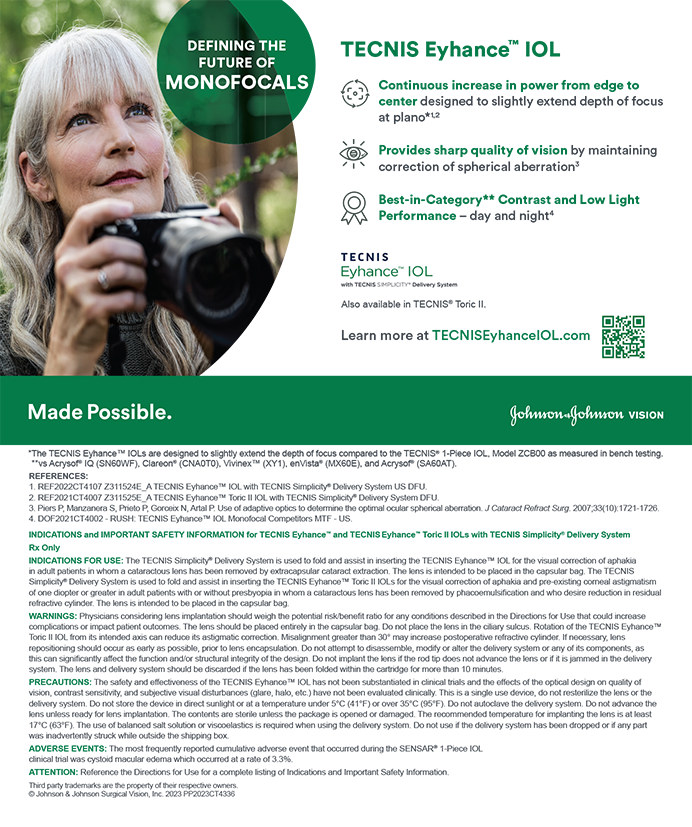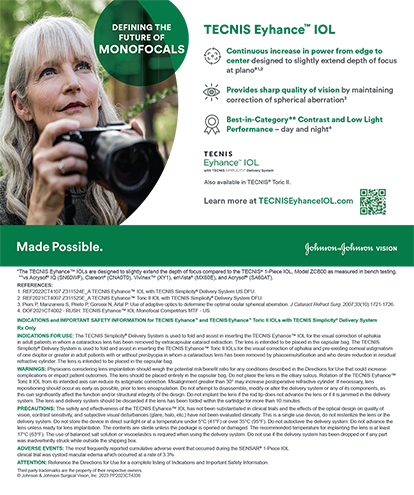The FDA's approval of Vision Blue (DORC International BV, Zuidland, the Netherlands) in December 2004 finally allowed US surgeons access to the capsular dye. Cataract & Refractive Surgery Today asked Fran Carleton, Operations Manager for Dutch Ophthalmic, USA (Kingston, NH), to share the story of how Vision Blue made it to the US market.
CRST: What clinical studies or data were submitted to the FDA, and where were these studies performed?Ms. Carleton: The clinical data were supported by peer-reviewed articles1-8 based on the 5-year market availability of Vision Blue in Europe and other countries. The studies were primarily conducted in Europe.
CRST: What were the results of the studies in terms of safety and efficacy?
Ms. Carleton: Vision Blue greatly enhanced surgeons' visualization of the capsulorhexis in eyes with mature cataracts. The dye provided a consistently clear outline of the capsulorhexis' peripheral rim through contrast between the stained rim and the adjacent lenticular mass. Improved visualization of radial capsular tears reduces the risk of complications related to the capsulorhexis. Surgeons were also able to see the leading edge of a “lost” capsulorhexis.
The studies did not show any adverse reactions or contraindications other than those mentioned in the product information. Complications included the discoloration of an IOL with a high water content9 and the temporary staining of the posterior capsule in a postvitrectomy eye.10
CRST: Was the FDA helpful and cooperative?Ms. Carleton: Yes, it was. The reviewers made themselves available to us and walked us through the approval process. Because DORC International BV is predominantly a device company, we found that very helpful.
CRST: What other organizations and/or individuals helped the company run the FDA drug submission, a process with which DORC International BV had no prior experience?
Ms. Carleton: We hired a consultant to help organize our effort, and we relied on our own quality assurance people in the Netherlands. The FDA provided guidance and really helped us to realize our goal of bringing Vision Blue to market in the US. The cooperation of several manufacturing facilities helped us to get the test criteria to the FDA as per the agency's guidance documents. Ophthalmologists willingly performed the studies, and Nancy McCann, Director of Government Relations for the ASCRS, volunteered the assistance of the organization and its members on behalf of trypan blue. We felt that both the FDA reviewers and ophthalmologists had patient safety and surgical performance in mind. They saw a need for this product and really worked to get it approved.
CRST: Would you briefly outline the US approval process?Ms. Carleton: In October 1999, DORC International BV introduced Vision Blue at the AAO annual meeting in Orlando, Florida. After checking with several consultants, it was our understanding that the product would be regulated as a class I device: ophthalmic marker. Vision Blue received an overwhelming response from the cataract community, and we continued to ship the product through mid-December. At that time, Dutch Ophthalmic, USA, was notified that discussion had arisen within the FDA about the proper classification of trypan blue—device or drug. The company decided to halt sales and promotion of the product until its regulatory status was clear. After discussions with the FDA during the year 2000, Dutch Ophthalmic, USA, pursued a Request for Designation and supplied information that would indicate that trypan blue was a device. The FDA decided that the product should be regulated through the Center for Drug Evaluation and Research. The company gathered information to move forward with a Request for Reconsideration in 2001. At a certain point in the process, it became clear that no reversal in the dye's classification would occur and that, if DORC International BV wanted to sell the product in the US, it would be as a drug. In 2002, work began on the new drug application to the FDA. It was submitted to the FDA in October 2003. Final approval of Vision Blue, as a drug, was obtained on December 16, 2004.
CRST: Why will the price of Vision Blue be higher for US surgeons versus ophthalmologists in Europe or Canada?Ms. Carleton: In Europe and Canada, Vision Blue has been classified as a device. The company must offset the fees associated with the drug application and the much higher cost of keeping a drug on the US market. n
Fran Carleton is Operations Manager for Dutch Ophthalmic, USA, DORC International BV's exclusive agent in the US. Ms. Carleton may be reached at (800) 753-8824; fran@dutchophthalmicusa.com.
1. Melles GRJ, de Waard PWT, Pameyer JH, et al. Trypan blue capsule staining to visualize the capsulorhexis in cataract surgery. J Cataract Refract Surg. 1999;25:7-9.
2. Melles GRJ, de Waard PW, Pameijer JH, Beekhuis WH. Staining the lens capsule with trypan blue in mature cataract surgery. Klin Monatsbl Augenheilkd. 1999;215:342-344.
3. Van Dooren BT, de Waard PW, Poort-van Nouhuys H, et al. Corneal endothelial cell density after trypan blue capsule staining in cataract surgery. J Cataract Refract Surg. 2002;28:574-575. 4. Nodarian M, Feys J, Sultan G, Salvanct-Bouccara A. Capsulorhexis staining by trypan blue in mature cataract surgery. J Fr Ophthalmol. 2001;24:274-276.
5. Sturmer J. Cataract surgery and the “blue miracle.” Klin Monatsbl Augenheilkd. 2002;219:191-195.
6. Jacob S, Agarwal A, Agarwal A, et al. Trypan blue as an adjunct for safe phacoemulsification in eyes with white cataract. J Cataract Refract Surg. 2002;28:1819-1825.
7. Bhartiya P, Sharma N, Ray M, et al. Trypan blue assisted phacoemulsification in corneal opacities. Br J Ophthalmol. 2002;86:857-859.
8. De Waard PWT, Budo CJ, Melles GRJ. Trypan blue capsular staining to “find” the leading edge of a “lost” capsulorhexis. Am J Ophthalmol. 2002;134:271-272.
9. Werner L, Apple DJ, Crema A, et al. Permanent blue discoloration of a hydrogel intraocular lens by intraoperative trypan blue. J Cataract Refract Surg. 2002;28:1279-1286.
10. Birchall W, Raynor MK, Turner GS. Inadvertent staining of the posterior lens capsule with trypan blue during phacoemulsification. Arch Ophthalmol. 2001;119:1082-1083.


